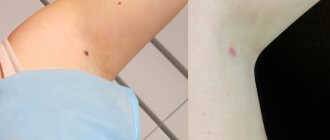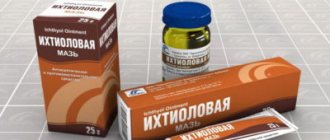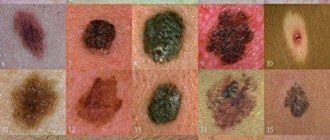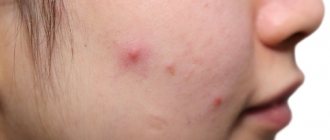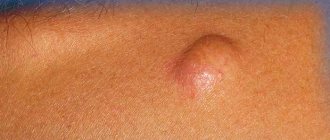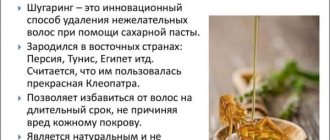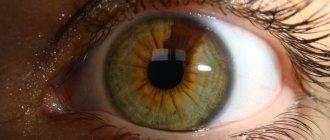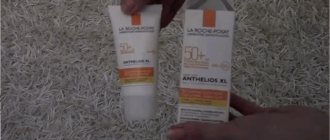Any surgical intervention, for whatever reason, causes a wound to the patient, which subsequently requires care until healing.
Unfortunately, quite often, in the process of restoring damaged tissues, various complications arise, the most common of which is suppuration. This happens no matter how carefully and correctly the operation was performed; even after all actions have been performed perfectly, the postoperative wound may begin to fester.
What is an abscess
Translated from Latin abscessus
means abscess. That’s right: an abscess is an inflammatory process associated with the formation of a purulent cavity in the tissues. It is located in the subcutaneous fatty tissue or in the muscles and is constantly growing due to an increase in the amount of pus. The latter is formed as a result of the vital activity of pyogenic bacteria that enter the body during surgery or during the early rehabilitation period.
The main classification of ulcers is related to their location. So, abscesses are distinguished:
- soft tissues;
- oral cavity;
- brain;
- lung;
- pelvis;
- liver;
- abdominal cavity;
- appendicular;
- retropharyngeal;
- interintestinal;
- subdiaphragmatic;
- spinal.
As long as the pus is in a sealed infiltration capsule, the patient is in no danger (except for the unpleasant symptoms that he experiences). But the membrane becomes thinner as it grows and can break through at any moment. Then the purulent exudate will begin to enter the intermuscular spaces, infecting healthy tissue. Inflammation associated with the rupture of an abscess is called phlegmon.
Dealing with phlegmon is more difficult than dealing with an abscess. In addition, this disease causes a greater number of severe complications due to the high probability of infection entering the lymphatic vessels. Therefore, it is important to have time to prevent capsule rupture.
Proper care
While the woman is in the postpartum ward, nurses perform daily treatment of postoperative wounds. Before discharge home, the obstetrician-gynecologist will tell you about proper care, how to behave when the suture festers after a cesarean section, as well as what to do if complications arise.
During the week after birth, the wound is lubricated with antiseptic solutions, usually brilliant green, and the bandages are changed. Simple actions help prevent situations where the suture festers after a caesarean section.
After 7-10 days, the sutures should be removed, but if they are made of absorbable materials, such manipulation will not be necessary.
If, after being discharged home, you find white discharge from the wound, this may indicate that the suture after a cesarean section is festering, so the first thing you need to do is consult a gynecologist.
Reasons for the development of postoperative abscess
The causative agents of purulent inflammation can be a variety of bacteria: staphylococcus, streptococcus, E. .
Open abdominal surgical interventions are especially dangerous, because... It is easier for infection to penetrate into a large wound. Although there are known cases of abscess development after laparoscopy. Most often, infection enters the body through poorly treated instruments. The hematogenous route of infection is also known: through blood transfusion.
By the way! More often, an abscess develops in people with weakened immune systems (chronic diseases, age). A healthy body sometimes manages to cope with the primary infection and prevent inflammation.
Failure to maintain sterility during dressings is also a common cause of the development of postoperative abscess. Moreover, it is often the patient himself who is to blame for this, who decided to change the bandage on his own or look under it. There are many bacteria in the air that can penetrate through the stitches into the wound and cause suppuration.
Signs and code according to ICD-10
ICD 10 code for suppuration of a postoperative wound is assigned to T81. The clinical picture of damage to the surgical site depends on the causative agent of the pathology. Staphylococci, streptococci, clostridia, Pseudomonas aeruginosa, and pneumococci can get inside damaged skin. Bacteria multiply inside the body. Their active life activity is manifested by local and systemic symptoms.
When a wound becomes infected with gram-positive flora, a person experiences a sharp increase in temperature on the 2nd or 3rd day after surgery. The patient associates the deterioration in general well-being with signs of pain in the damaged area.
During a postoperative medical examination, swelling and hyperemia of the edges of the skin defect with suppuration are detected. Palpation causes unpleasant pain. If the infectious process is localized under the aponeurosis, subcutaneous adipose tissue, symptoms of inflammation appear later. Late detection of the pathological process ends in the development of infectious complications.
Gram-negative flora causes a temperature reaction on the 3-4 postoperative day. Intoxication, pain syndromes are more pronounced than when the wound is infected with gram-positive bacteria. The patient shows signs of involvement of the cardiovascular system in the pathological process. He suffers from palpitations, tachycardia, pressure changes, and cardialgia.
Non-clostridial anaerobic microflora causes systemic and local manifestations of suppuration from the first days. The patient experiences high body temperature, severe pain in the area of the fresh postoperative wound, weakness, and decreased appetite. When examining the surgical site, pronounced swelling and hyperemia of the pathological area of the body is determined. Based on these signs, infection with bacterial agents can be suspected.
2-3 days after the development of suppuration, secretion begins to be released from the wound. With a staphylococcal infection, it has a creamy consistency and a yellow-green color. There is no unpleasant odor coming from the postoperative area.
A sign of the activity of Pseudomonas aeruginosa is manifested by the formation of a blue-green secretion with a liquid consistency. A specific smell and characteristic discharge from the wound help to suspect infection with this pathogen.
The diagnosis of suppuration of the postoperative area is established on the basis of clinical signs of the disease, medical history, provoking factors, and the results of diagnostic studies.
How does an abscess manifest?
Symptoms of an abscess begin to appear immediately after the formation of an abscess. But due to their nonspecificity, it is not immediately possible to understand that this is inflammation. The person experiences general weakness, nervousness, and sleeps poorly. The skin may turn red at the site of suppuration. Pain may occur when pressing.
Over time, as the capsule begins to grow, signs of an abscess become more obvious. To the weakness is added an elevated temperature (from 37 to 37.8), pain in the area of the abscess becomes sharp, hyperemia and swelling are more pronounced. The affected area of the body begins to function worse: if it is, for example, an elbow, it does not bend; if an abscess has formed in the interintestinal space, problems with stool arise, etc.
Proper care
While the woman is in the postpartum ward, nurses perform daily treatment of postoperative wounds. Before discharge home, the obstetrician-gynecologist will tell you about proper care, how to behave when the suture festers after a cesarean section, as well as what to do if complications arise.
During the week after birth, the wound is lubricated with antiseptic solutions, usually brilliant green, and the bandages are changed. Simple actions help prevent situations where the suture festers after a caesarean section.
After 7-10 days, the sutures should be removed, but if they are made of absorbable materials, such manipulation will not be necessary.
If, after being discharged home, you find white discharge from the wound, this may indicate that the suture after a cesarean section is festering, so the first thing you need to do is consult a gynecologist.
Treatment methods for abscesses
If the abscess is located close to the surface of the skin (for example, a soft tissue abscess), then the doctor will be able to diagnose it visually and by palpation. Internal suppuration requires additional diagnostic methods. This is a blood test, x-ray or ultrasound, and if necessary an MRI.
Treatment of an abscess begins with antibacterial therapy, which should partially suppress the pyogenic microflora. But a course of antibiotics is not able to destroy the developed abscess, so it can only be gotten rid of through surgery. The abscess must be opened and its cavity completely cleared of purulent exudate.
Attention! Under no circumstances should you open an abscess at home! Do-it-yourself activities can lead to blood poisoning and pus getting into healthy tissue. And this is the risk of developing a recurrent abscess or the formation of phlegmon.
Purulent lesions of the skin and subcutaneous tissue
Pathological processes in the skin and underlying layers are very common in surgical practice. The skin and its appendages are the body’s first protective barrier from various adverse effects.
Negative factors that provoke the development of skin inflammation are:
- mechanical damage (scratches, abrasions and cuts, scratching);
- exposure to high and low temperatures (burn, frostbite);
- chemical agents (household alkalis, acids, abuse of antiseptics and detergents);
- excessive sweating and sebum secretion can cause purulent inflammation of the skin;
- poor hygiene (especially in obese people);
- diseases of internal organs (pathologies of the endocrine, digestive systems;
- ingrown nail.
Technique for opening an abscess
The opening of the abscess is performed strictly in a hospital setting. If the abscess is located deep (in the abdominal cavity, in the retropharyngeal space, in the liver), then a full-fledged operation is performed under general anesthesia. Superficial soft tissue abscesses can be opened directly in the dressing room under local anesthesia.
The technique of opening and removing an abscess implies a certain algorithm of actions.
- The area of inflammation is treated with an antiseptic and then injected with an anesthetic.
- A scalpel is used to cut the tissue at the site of greatest inflammation (bulge). The average length of the incision is 2-2.5 cm
- Using a Hartmann syringe, the incision is widened and the connecting bridges are excised.
- The abscess cavity is cleaned of exudate manually or with electric suction.
- Using a finger, the surgeon examines the cleaned cavity for residual pus.
- The cavity is washed with an antiseptic.
- A drainage is installed, with which you can wash the wound. Also, through the hollow tube, the remaining pus and other pathological fluids can escape, which can provoke repeated suppuration.
- Stitches are applied. On top of them, applications are made with antibacterial ointments (Vishnevsky, Levomekol, etc.) and a sterile bandage.
If the operation is performed under general anesthesia, the technique becomes more complicated. First, doctors need to get to the abscess by excision of tissue. This must be done extremely carefully so as not to open the abscess ahead of time and to prevent the outpouring of pus onto healthy tissue. The number of stitches required also increases, and the drainage system is more complex.
Supuration of the suture after cesarean section
If you had a cesarean section, it is very important to monitor the appearance of the suture and follow the post-operative instructions of the doctor very carefully so as not to introduce an infection into the suture area. Call your doctor for advice if you have any of these symptoms after leaving the hospital:
- severe abdominal pain;
- redness at the incision site;
- swelling of the area where the incision was made;
- discharge of pus in the suture area;
- pain at the incision site that does not go away or gets worse;
- painful urination;
- bleeding that contains large clots;
- leg pain or swelling.
You should regularly check the condition of the stitch and diagnose it for infection. It is necessary to check the appearance of the wound and monitor the healing process. If the suture festers after a cesarean section, then you need to see a doctor. He will use a special needle to remove pus from the wound. The liquid may be sent to a laboratory to be tested for bacteria.
You need to be extremely careful, as infection in the suture area can spread and cause problems with various organs, skin, blood and local tissues. This is usually the result of either staphylococcal or streptococcal bacteria. Redness and suppuration can quickly spread to the area around the suture.
Bacteria can also cause an abscess. Infection at the surgical incision site results in redness, tenderness and swelling along the incision, and pus may collect there. Abscesses can form when an incision is made into the uterus, scar tissue, ovaries, and other tissues or adjacent organs if infection is present.
Some bacteria that cause abscesses can also cause endometritis. This is irritation of the lining of the uterus after a cesarean section, which can lead to:
- pain;
- abnormal bleeding;
- swelling;
- fever;
- malaise.
In this article we have collected all the recommendations for recovery after surgery.
Postoperative recovery of the patient
After opening the abscess, antibiotic therapy continues. It will allow you to completely destroy pyogenic bacteria that have managed to spread throughout the body during the period of maturation of the abscess. Additionally, the patient's condition is supported by vitamin drips.
Dressings are also carried out regularly. This is done under sterile conditions at intervals of a day (sometimes more often). After the drainage is removed and the sutures are removed, the patient is discharged home. If the operation was complicated, then for several days he will have to go to the clinic at his place of residence for dressings. After opening a soft tissue abscess, the wound heals faster, so sometimes a person is allowed to bandage it at home.
Sometimes an abscess can develop even after a person cuts himself with a knife or steps on a nail. Competent prevention, which consists of timely treatment of the wound with an antiseptic, will help prevent suppuration. Following the doctor’s recommendations for caring for sutures and wounds will help reduce the risk of developing a postoperative purulent abscess.
How long does it normally take for an external suture to heal?
The duration of healing of sutures after cesarean section is individual. This period depends on many factors:
- individual characteristics of a woman’s body;
- compliance with wound care rules;
- the presence or absence of complications in the form of suppuration, inflammation and discrepancy.
In addition, this period is also affected by the type of seam. With a vertical incision, the wound heals on average within 2 months. At the same time, discomfort may be periodically felt in the damaged area throughout the 1st year.
Healing of a horizontal suture, as a rule, proceeds much faster. In most cases, this period is no more than one and a half months. Despite this, just as in the first case, it can cause unpleasant and painful sensations for another 12 months after the birth of the child.
Doctors allow at least 2 years for complete restoration of damaged tissue after a cesarean section, when a woman stops feeling any pain and discomfort in the area of the suture.


